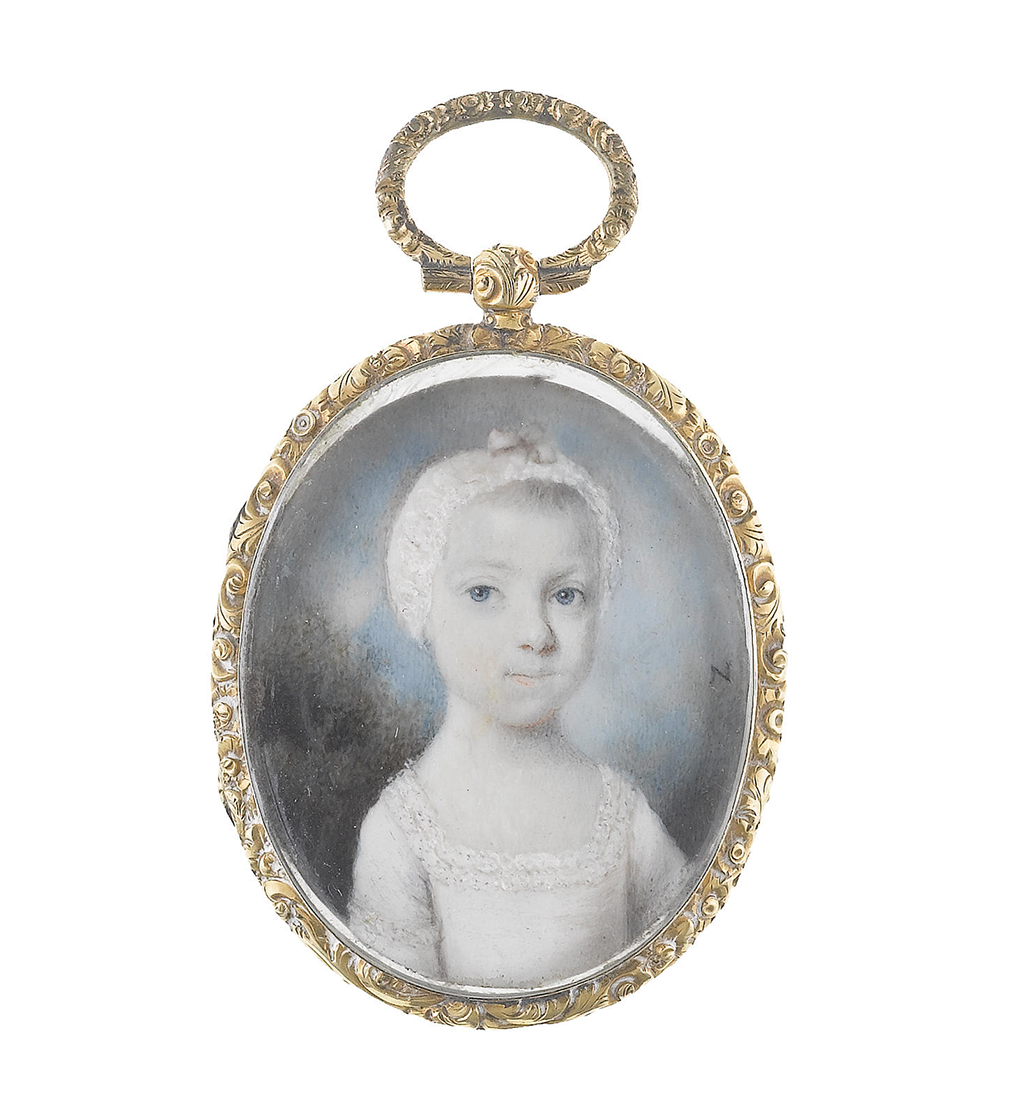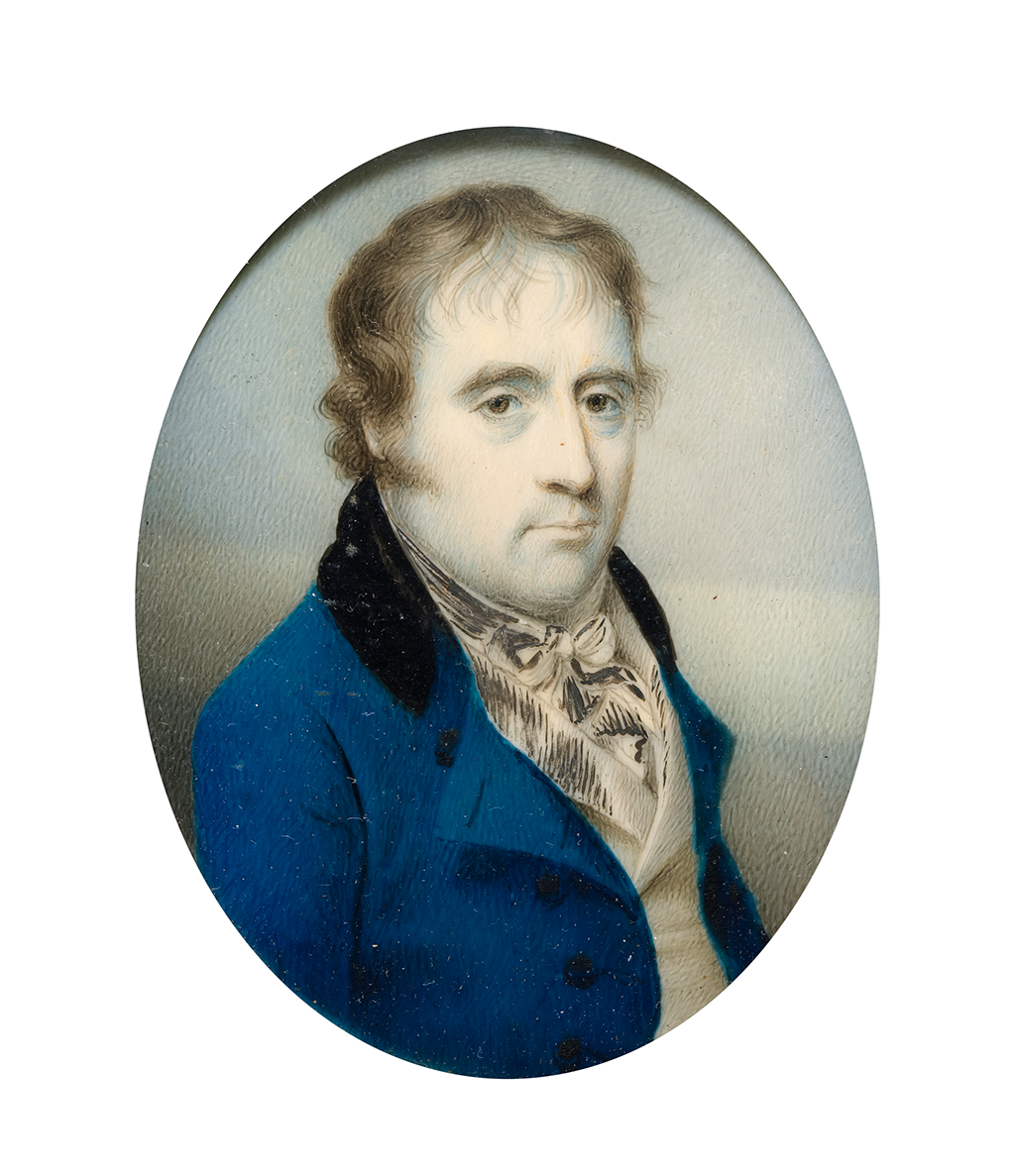Citation
Chicago:
Aimee Marcereau DeGalan, “Unknown, Portrait of a Woman, ca. 1775–80,” catalogue entry in Aimee Marcereau DeGalan, Blythe Sobol, and Maggie Keenan, The Starr Collection of Portrait Miniatures, 1500–1850: The Collections of the Nelson-Atkins Museum of Art, vol. 3, ed. Aimee Marcereau DeGalan (Kansas City, MO: Nelson-Atkins Museum of Art, 2024), https://doi.org/10.37764/8322.5.1660.
MLA:
Marcereau DeGalan, Aimee. “Unknown, Portrait of a Woman, ca. 1775–80,” catalogue entry. Aimee Marcereau DeGalan, Blythe Sobol, and Maggie Keenan. The Starr Collection of Portrait Miniatures, 1500–1850: The Collections of the Nelson-Atkins Museum of Art, edited by Aimee Marcereau DeGalan, vol. 3, Nelson-Atkins Museum of Art, 2024. doi: 10.37764/8322.5.1660.
Catalogue Entry
The current miniature and Figure 1, F58-60/94, a pair of unsigned grisaille: A monotone, often high-contrast style of drawing or painting rendered entirely in shades of gray, black, and white. Grisaille was implemented by artists such as Thomas Forster working in plumbago, also known as graphite. portraits of women, present a mystery of identity, concerning both the artist and the sitters. Initially attributed to English artist James Nixon on entering the Nelson-Atkins collection in 1958, these works defy Nixon’s typical style, which is characterized by soft, fleshy sitters with rose-colored skin tones and a more painterly facture: The artist’s characteristic handling of paint..1For an example of Nixon’s more painterly approach, see James Nixon, Portrait of Elizabeth, Countess of Carysfort, ca. 1780, watercolor and gouache on ivory, gilt metal frame, glazed hair reverse, 2 5/8 in. (6.5 cm) diam., Christie’s, London, “Old Masters Day Sale,” December 9, 2021, lot 318, https://www.sothebys.com/en/buy/auction/2021/old-masters-day-sale-2/portrait-of-elizabeth-countess-of-carysfort-d-1783. Although Nixon occasionally worked in grisaille (Fig. 2), the approach to the figures in his known works diverges from the two portraits under consideration here, which also notably lack Nixon’s signature cursive “N.”

In these two examples, the artist presents a more structured execution of the figures than is characteristic of Nixon. The portrait of the woman with piercing blue eyes (Fig. 1) is rendered with more linear precision than her fleshier brown-eyed counterpart (F58-60/93), whose facial structure comprises a mixture of lines, stippling: Producing a gradation of light and shade by drawing or painting small points, larger dots, or longer strokes. dots, and faint hatched: A technique using closely spaced parallel lines to create a shaded effect. When lines are placed at an angle to one another, the technique is called cross-hatching.. Despite variations, both sitters share a pale wash of peach across their lips and cheeks.2The dress of the blue-eyed sitter also contains a highlight at her shoulders, to differentiate it from the otherwise bare ivory substrate. Overall, however, their palettes are limited to tonal shades of gray and brown, with large portions of the face, neck, and chest left as bare ivory: The hard white substance originating from elephant, walrus, or narwhal tusks, often used as the support for portrait miniatures..
Several members of the Irish school embraced grisaille chalk and charcoal drawings, including Robert Healy (1743–1771), Charles Forrest (ca. 1750–after 1780), and Charles Robertson (ca. 1760–1821).3See John Turpin, A School of Art in Dublin Since the Eighteenth Century: A History of the National College of Art and Design (Dublin: Gill and Macmillan, 1995), 10, 19, 39. Healy worked exclusively in grisaille chalk drawings; however, his oeuvre is exceedingly small, with only twenty-five known works.4Daniel Beaumont, “Robert Healy,” Dictionary of Irish Biography, October 2009, https://doi.org/10.3318/dib.003884.v1. See also Neil Jeffares, “Robert Healy,” Dictionary of Pastellists before 1800, September 10, 2022, https://web.archive.org/web/20240921123833/http://www.pastellists.com/Articles/Healy.pdf. It remains unknown whether he produced portrait miniatures; moreover, it is likely that the miniatures seen here postdate the artist’s untimely death.5Healy had a younger brother, William Healy (fl. 1770), who was also an artist. “He attended the Dublin Society Schools in 1769 and exhibited there in 1774 while living at Cork Hill, Dublin. He made copies of his late brother’s work, and the surviving chalk drawings of Robert and William Healy are virtually indistinguishable”; Daniel Beaumont, “Robert Healy.” A portrait of William Healy by his brother is also in the National Gallery of Ireland: Robert Healy, William Healy, Artist and Brother of Robert, 1767, black and white chalk on paper, 19 5/16 x 17 1/16 in. (49 x 43.4 cm), National Gallery of Ireland, Dublin, http://onlinecollection.nationalgallery.ie/objects/6161/william-healy-artist-and-brother-of-robert. Another member of the Dublin School of Drawing who worked in grisaille exclusively was Francis Robert West (1749–1809), although like Healy, there are no known portrait miniatures by his hand. Charles Forrest, however, did make portrait miniatures, including an example in the Nelson-Atkins collection. Although there is a similarity in the way both Forrest and the present artist place the figures low within the picture plane, revealing very little of the sitters’ dresses, Forrest was much more refined in his mark-making than the present artist, whose strong graphic qualities suggest previous work or study with a printmaker. Charles Robertson occasionally worked in grisaille; however, unlike the artist of the present works, Robertson employed slate gray-blue to build up the shadows under his sitter’s eyes, around their mouth, and in the hollows of their cheeks (Figs. 3, 4).6For more on Charles Robertson, see Paul Caffrey, John Comerford and the Portrait Miniature in Ireland ca. 1620–1850 (Kilkenny: Kilkenny Archaeological Society, 1999), 27. While both the present artist and Robertson applied linear brushwork in a network of cross-hatched lines to build up form, Robertson’s efforts are much subtler. Moreover, the Nelson-Atkins portraits are less than two inches high, suggesting they date to around 1775–80, or the end of the so-called Modest School: A term coined by art historian Graham Reynolds to describe a group of minor miniaturists working from around 1740 to the late 1770s, whose works are typically under three inches tall. period, placing them too early in Robertson’s career for him to be a viable candidate.7I am grateful to Stephen Lloyd for suggesting this date during his October 2023 visit. Notes in NAMA curatorial files.

While the artist remains unknown, the Irish school’s embrace of grisaille, primarily in drawing and pastel, offers a tantalizing possibility. Although the medium diverges from watercolor on ivory, the matrix most typically associated with portrait miniatures, the Irish school’s penchant for a limited palette might have cultivated a taste for grisaille in miniatures.8I am grateful to Neil Jeffares for sharing his insight on the Irish school of pastellists, many of whom employed grisaille. Jeffares to the author, February 28, 2024, NAMA curatorial files. This raises the intriguing prospect that the artist behind these portraits could be of Irish origin.
Questions also linger regarding the portraits’ completion and context of production. Were these preparatory works? Were they never completed? Identical in scale, and framed in matching bracelet mounts, they might have served as friendship bracelets for unknown women, their identities lost yet united in the Starr Collection in perpetuity.
Notes
-
For an example of Nixon’s more painterly approach, see James Nixon, Portrait of Elizabeth, Countess of Carysfort, ca. 1780, watercolor and gouache on ivory, gilt metal frame, glazed hair reverse, 2 5/8 in. (6.5 cm) diam., Christie’s, London, “Old Masters Day Sale,” December 9, 2021, lot 318, https://www.sothebys.com/en/buy/auction/2021/old-masters-day-sale-2/portrait-of-elizabeth-countess-of-carysfort-d-1783.
-
The dress of the blue-eyed sitter also contains a highlight at her shoulders, to differentiate it from the otherwise bare ivory substrate.
-
See John Turpin, A School of Art in Dublin Since the Eighteenth Century: A History of the National College of Art and Design (Dublin: Gill and Macmillan, 1995), 10, 19, 39.
-
Daniel Beaumont, “Robert Healy,” Dictionary of Irish Biography, October 2009, https://doi.org/10.3318/dib.003884.v1. See also Neil Jeffares, “Robert Healy,” Dictionary of Pastellists before 1800, September 10, 2022, https://web.archive.org/web/20240921123833/http://www.pastellists.com/Articles/Healy.pdf.
-
Healy had a younger brother, William Healy (fl. 1770), who was also an artist. “He attended the Dublin Society Schools in 1769 and exhibited there in 1774 while living at Cork Hill, Dublin. He made copies of his late brother’s work, and the surviving chalk drawings of Robert and William Healy are virtually indistinguishable”; Daniel Beaumont, “Robert Healy.” A portrait of William Healy by his brother is also in the National Gallery of Ireland: Robert Healy, William Healy, Artist and Brother of Robert, 1767, black and white chalk on paper, 19 5/16 x 17 1/16 in. (49 x 43.4 cm), National Gallery of Ireland, Dublin, http://onlinecollection.nationalgallery.ie/objects/6161/william-healy-artist-and-brother-of-robert. Another member of the Dublin School of Drawing who worked in grisaille exclusively was Francis Robert West (1749–1809), although like Healy, there are no known portrait miniatures by his hand.
-
For more on Charles Robertson, see Paul Caffrey, John Comerford and the Portrait Miniature in Ireland ca. 1620–1850 (Kilkenny: Kilkenny Archaeological Society, 1999), 27.
-
I am grateful to Stephen Lloyd for suggesting this date during his October 2023 visit. Notes in NAMA curatorial files.
-
I am grateful to Neil Jeffares for sharing his insight on the Irish school of pastellists, many of whom employed grisaille. Jeffares to the author, February 28, 2024, NAMA curatorial files.
Provenance
Mr. John W. (1905–2000) and Mrs. Martha Jane (1906–2011) Starr, Kansas City, MO, by 1958;
Their gift to The Nelson-Atkins Museum of Art, Kansas City, MO, 1958.
References
Ross E. Taggart, The Starr Collection of Miniatures in the William Rockhill Nelson Gallery (Kansas City, MO: Nelson Gallery-Atkins Museum, 1971), no. 152, p. 53, (repro.), as Unknown Lady.
No known related works or exhibitions at this time. If you have additional information on this object, please tell us more.